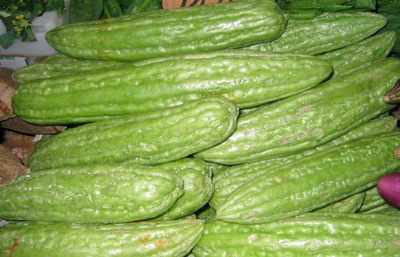Bitter melon comes in a variety of shapes and sizes.
The cultivar common in China is 20–30 cm (7.9–11.8 in) long, oblong with bluntly tapering ends and pale green in color, with a gently undulating, warty surface.
The bitter melon more typical of India has a narrower shape with pointed ends, and a surface covered with jagged, triangular “teeth” and ridges. It is green to white in color. (source)
So can guinea pigs eat bitter lemon?
Let’s take a look and their nutritional data and find out more.
In particular, their acidic, water, sugar, fat, salt, calcium and phosphorus content is of most interest as far as guinea pigs are concerned.
Nutritional value per 100 g (3.5 oz)
Energy 79 kJ (19 kcal)
Carbohydrates
4.32 g
Sugars 1.95 g
Dietary fiber 2 g
Fat
0.18 g
Protein
0.84 g
Vitamins
Vitamin A equiv.
beta-carotene
lutein zeaxanthin
(1%) 6 μg
(1%) 68 μg
1323 μg
Thiamine (B1) (4%) 0.051 mg
Riboflavin (B2) (4%) 0.053 mg
Niacin (B3) (2%) 0.28 mg
Pantothenic acid (B5) (4%) 0.193 mg
Vitamin B6 (3%) 0.041 mg
Folate (B9) (13%) 51 μg
Vitamin C (40%) 33 mg
Vit E (1%) 0.14 mg
Vitamin K (5%) 4.8 μg
Minerals
Calcium (1%) 9 mg
Iron (3%) 0.38 mg
Magnesium (5%) 16 mg
Manganese (4%) 0.086 mg
Phosphorus (5%) 36 mg
Potassium (7%) 319 mg
Sodium (0%) 6 mg
Zinc (8%) 0.77 mg
Other constituents
Water 93.95 g
source wikipedia
As you can see, bitter lemon contains a huge amount of water, a little phosphorus, quite a lot of acidic content, a hint of calcium, fat and sugar.
This means that it is not good for guinea pigs to eat. The huge amount of water content is not good for them and will give them bloat. A food to avoid feeding them.


